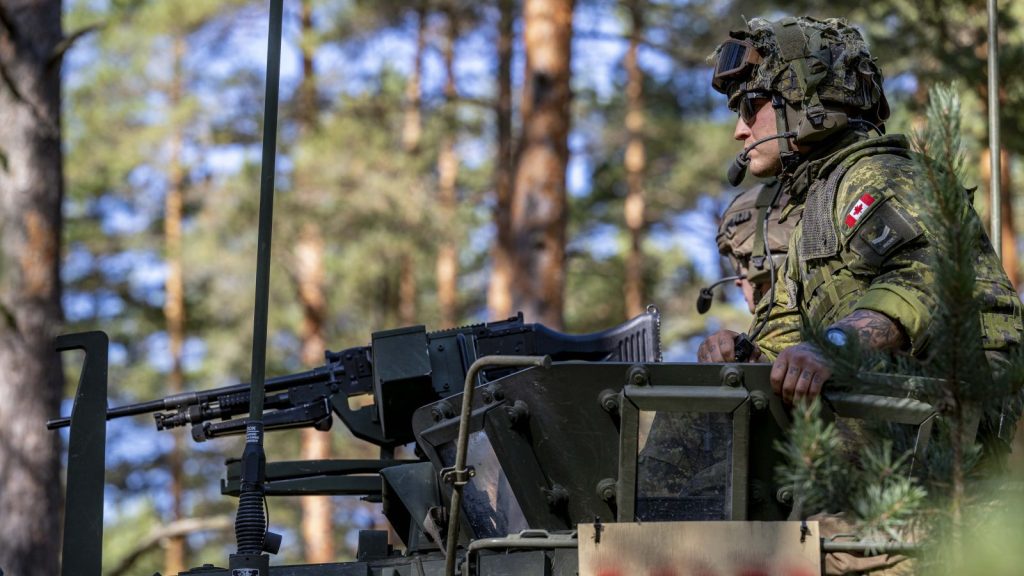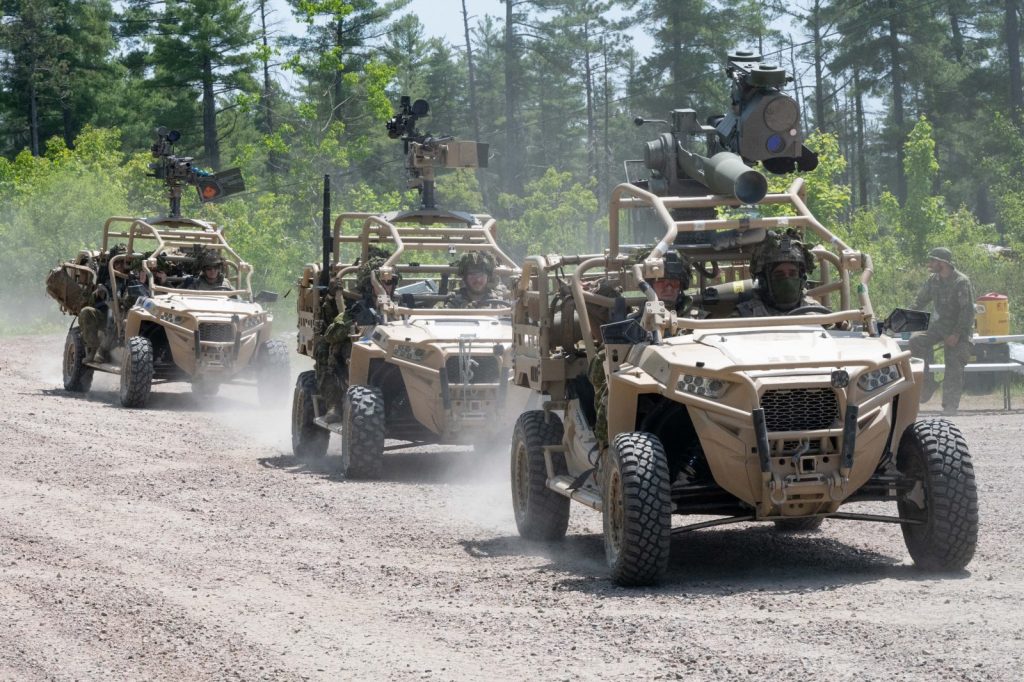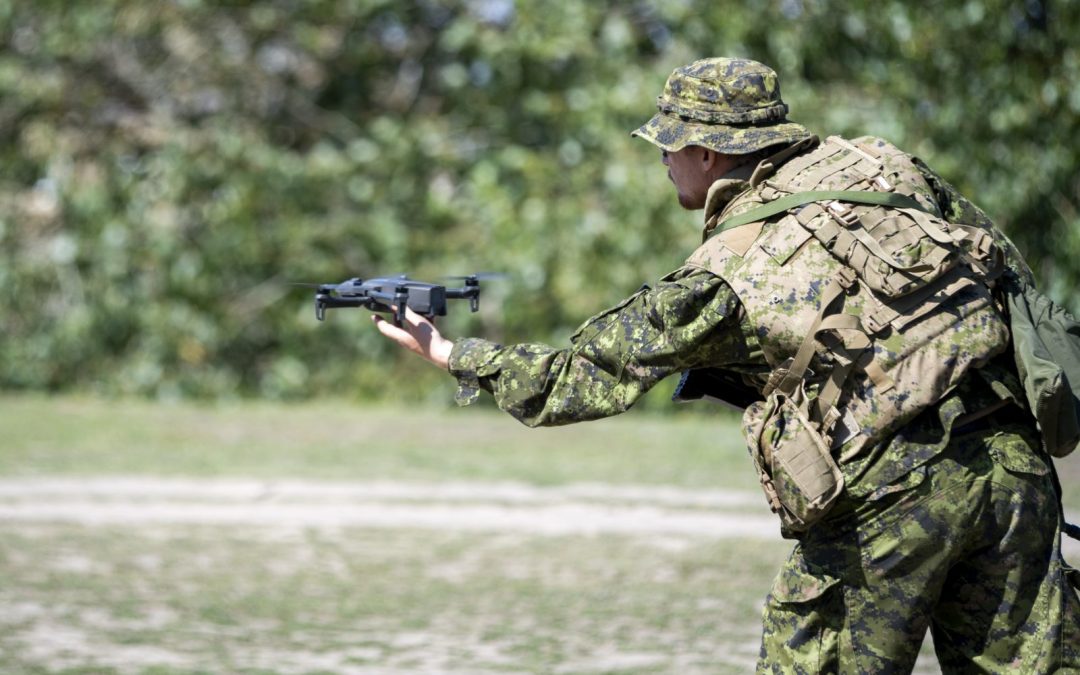by Chris Thatcher
“The operational art is about being unpredictable,” Lieutenant-General Joe Paul noted as he closed a lengthy discussion about Operation Reassurance and the Canadian-led multinational enhanced Forward Presence (eFP) Battle Group in Latvia. “It’s about offering your opponent some dilemmas. The more agile and nimble you are, the less predictable you are.”
Faced with an understrength force, gaps in critical capability, and allies with their own national priorities, the Army Commander has adopted an approach to brigade building that draws on the Army’s history — in the Balkans and elsewhere — to develop a flexible force with advanced capability that can be projected into Eastern Europe. “If you want a new idea, read an old book,” he joked.
“Agility” is the aim of a force structure he is contemplating for Forward Land Forces Multinational Brigade Latvia (MNB-L) that is gradually taking shape, but it could well be the keystone to the building process itself.
In June 2022, the government reaffirmed its intent to lead the battle group in Latvia that until recently involved 10 nations. At the same time, the government committed to working with NATO allies to generate and stage the necessary forces to surge that formation to a combat capable brigade.
Since then, Paul and Army senior leaders, including those in Task Force Latvia, have been engaging with battle group partners and other nations in NATO to determine just how they meet that commitment.
When Canada first assumed the lead for the battle group in 2017, there were four such formations — in Poland, Latvia, Lithuania and Estonia — and contributors were readily available to step forward. In 2022, four more were established in Bulgaria, Hungary, Romania and Slovakia. Now, all eight battle groups are in various stages of scaling to the strength of brigades. Contributing partners to Latvia such as Slovakia and Spain are now either hosting their own brigade or assuming the leadership of one.
“The force generation pressure [across NATO] is real,” said Paul.
The expanded number of brigades has resulted in a realignment of the Canadian-led formation, he added. Spain remains a contributor for the time being, Italy and Poland will continue to provide tanks and other capabilities, and Denmark has now come aboard.
Discussions among partners have solidified the overall structure for the brigade and its three manoeuvre battle groups. “The big muscle movements are taking shape, but we’re not yet down to the sub-unit level in terms of who is going to be providing what,” said Paul. “For instance, we are now drilling into who’s going to be generating what for the indirect fires battalion. We have a little more clarity regarding combat engineers and reconnaissance squadrons. There are still a few moving parts, but we have that rudimentary skeleton, and there’s going to be additional engagement.”
Two of the three battle groups will be mostly generated by Canada. As is currently the case, one will be stationed in Latvia and augmented by allies, though with “a little more Canadians” than the current multi-nation composition, he said.
The other will be delivered by the three light infantry battalions of the Canadian Mechanized Brigade Groups, and surged into theatre for six- to eight-week periods for intensive training in Latvia or elsewhere in Europe.
“This is how we’re going to be mitigating the force generation pressure. It is going to be just-in-time delivery, show the flag, and then back to your garrison,” said Paul. “The people serving with the three light infantry battalions, reinforced by Reserves, are going to be on super short notice to go to Latvia.
“This is nothing new. We did that with Bosnia in the old days. This is what our allies, including the Americans, are doing now.”
Brigade headquarters will be stationed in Latvia for a full year, and the battalions will cycle through every six months or surge as required.
“The light infantry battalion that we have on standby can be projected on the other side of the planet in a heartbeat,” he said, noting the reach of the Royal Canadian Air Force (RCAF) CC-177 Globemaster.
That surge into Europe will be in conjunction with annual rotating deployments to the U.S. Army’s Joint Pacific Multinational Readiness Center (JPMRC) in Fairbanks, Alaska or the Joint Readiness Training Center at Fort Johnson, Louisiana.
“I want to have a versatile instrument that will be capable of operating in multiple types of environments,” said Paul. “Young soldiers serving in these light infantry battalions, over a window of five or six years, will have seen a little bit of Europe, a little bit of Alaska, the Canadian Arctic, and the Bayou in Louisiana.”

A member of the 1st Battalion, The Royal Canadian Regiment, transmits a message on the radio during a road move in Light Armoured Vehicle 6.0 during Operation Fortress in Latvia in September 2023. Photo: Cpl Lynette Ai Dang
URGENT ACQUISITION
Since MNB-L was first announced, Paul has acknowledged that if there are gaps in its capabilities, Canada, as the lead nation, will have to fill them. In the weeks before he spoke with Canadian Army Today, funding for some of those was finalized, he said, “and we know how much national treasure is going to be allocated to us when it comes to enabling appropriations for the brigade.”
He wouldn’t reveal the number but said, “I’m super happy with the amount that we’ve been given.”
The details of a procurement strategy for fast-tracking the equipment are still being developed by the Army and Assistant Deputy Minister, Materiel (ADM(Mat)).
Paul’s top priority remains C4ISR, that critical blend of command, control, communications, computers, intelligence, surveillance, and reconnaissance capabilities. The Army’s Land C4ISR program of six distinct projects is well underway, but the brigade will require the necessary sensors, communication systems and battlefield management suite far sooner than the program can deliver. “I need to deliver something quick, fast and furious,” he said.
Paul is also requesting more anti-tank weaponry, ground-based air defence systems, and counter-uncrewed aerial systems (C-UAS). The Army is already pushing through three urgent operational requirements (UORs) to acquire portable anti-X missile systems (PAXM), air defence and CUAS for dismounted troops, fixed sites, and vehicles within the next 12 to 24 months.
But the brigade itself will need layered air defence systems capable of defeating threats and providing protection to the MNB-L, including loitering munitions, he said.
The funding includes more ammunition, some of which will be pre-positioned in theatre, and a plan to refurbish the armoured Heavy Support Vehicle System logistic trucks that have been parked in Longue-Pointe, near Montreal, since the end of the Afghanistan mission. “Ukraine has clearly shown us that you need to protect your supply chain,” he said.
Funding has also been secured for a tactical vehicle for the light infantry battalions. Exactly what that will be is still to be determined, Paul noted, but as part of the Light Forces Enhancement (LFE) project, the Army did some testing with a light tactical vehicle with the light battalions to inform its mobility requirements. Last year, the 3rd Battalion, The Royal Canadian Regiment, conducted weapons tests from the vehicle with a .50 calibre heavy machine gun, 40 mm grenade launcher, and BGM-71 TOW (Tube-launched, Optically-tracked, Wire-guided) anti-tank missile.
The plan is not to fast-track LFE so much as deliver a precursor to what the LFE vehicle might be. “LFE, as a major capital project, cannot deliver quickly enough,” he said. “So, what the Army and ADM(Mat) are going to be proposing is that, as we keep working on the major capital project, [we] speed up a slice of it.”
The consequence of concentrating limited Directorate of Land Requirements staff on the delivery of UORs will likely be a slowdown in some of the major capital projects, Paul acknowledged. While that might frustrate companies invested in those projects, he argued the UORs need to be seen as an investment. The Eastern European theatre will provide “an amazing laboratory where the Army can fine tune and test. Whatever kit we end up getting [for the brigade], we’re going to have the opportunity to work with it … and that will certainly inform the follow-on major capital projects and our doctrine.”
As part of its digital transformation, the Army will also seek to push forward much of the experimentation that has been conducted by various units, especially in Petawawa, as the brigades rotate through Latvia.
Other Canadian Armed Forces (CAF) capabilities likely to be deployed in the coming years include a tactical aviation capability from the Air Force and a Role 2 medical facility.
The build up of personnel and equipment will be conducted in phases over the next three six-month rotations, to reach full capability in 2026. Camp Adazi in Latvia has limits in what it can absorb, so the CAF will need to look more broadly across the region, Paul noted. As much as possible, the goal will be to pre-position equipment and surge personnel as required.
“We need to have these logistical nodes spread out,” he said, to minimize optimal targets. Latvia “is only the tip of the bayonet. When I’m looking at [the theatre], I’m looking at the whole continent.”
That broad perspective applies to training as well, he stated. The Canadian Army Doctrine and Training Centre is exploring ways to deliver a validation training program in theatre that would replace some large exercises like Maple Resolve, and capitalize on the training venues of countries in the region.
“Since I see the Russian threat as being out there for probably a good decade, if not more, we need to ensure that when you go back for your third, fourth or fifth tour in Latvia, it is going to be interesting, challenging, and appealing,” Paul said.

Members of the 3rd Battalion, The Royal Canadian Regiment, in Exercise Lethal Weapon to prove the concept of adding anti-armour capabilities to the MRZR-D to increase the battlefield efficiency of light infantry battalions. Photo: Pte Jennifer Froome
RESERVE STRENGTH
Like many of its allies, the CAF is struggling with personnel shortages. The Army is about 7,000 people short of its establishment, 4,000 in the Reserve Force and 3,000 in the Regular Force. Surging the light battalions as required will mitigate some of the strain on the Army, and ensure capacity at home to support government responses to floods, forest fires and other domestic emergencies. But Paul also intends to draw heavily on Reserve members.
“There’s no doubt in my mind that the Reserves are going to play a critical role,” he said. “I’ve asked my division commanders to aim at having 20 percent Reservists on every rotation.”
The Army is adjusting its Managed Readiness System to the reality in Latvia, and at the Combined Army Conference in September, division and brigade leaders “fine-tuned who’s going to be providing what, when and where between now and 2026,” said Paul. With the number of Reservists needed to meet the required troop presence, the Army is looking to increase the pre-deployment time each Reservist will have with their training unit. “Ideally, we can get to up to six months of pre-deployment integration, much like we did in the Afghanistan period.”
6 Canadian Combat Support Brigade (6 CCSB), especially, will require significant augmentation. Units such as the 4th Artillery Regiment (General Support), which could be deploying a CU-172 Blackjack troop to Latvia in 2024, will be the destination for many of the urgent air defence and counter-UAS capabilities needed in theatre.
“The intent is certainly to invest into that regiment,” said Paul. “The command team there knows it’s coming.”
The commander of the 5th Canadian Division is looking at the affiliation among Regular force and Reserve units in eastern Canada to directly bolster some of 6 CCSB’s capacity.
“There will come a point where we need to ensure that it is crystal clear between the Regular Force and the Reserve Force who is supporting who,” he said. “The key thing to me is to ensure that we have a level of predictability.”
Nothing is cast in stone, and events in Europe could rapidly change the picture — and the planning — but for the next two years, domestic missions aside, most of the Army’s focus will be in one direction.
“It’s all about between now and the end of 2025,” said Paul. “Because by early 2026, we need to be ready to roll.”


There is a lot of optimism in that article, and doesn’t appear to be a lot of realism. The statement ““The light infantry battalion that we have on standby can be projected on the other side of the planet in a heartbeat,” he said, noting the reach of the Royal Canadian Air Force (RCAF) CC-177 Globemaster.” seems particularly overstated, given the number of CC-177s actually available at any given time. I suggest that Latvia could actually be overrun before the first aircraft would arrive. The likelihood that military families will endure the constant surges is also extremely optimistic. Given the shortage of personnel it is likely than many infanteers will “surge” again and again, leading to even more shortages. The ability of senior officers to project success in the light of constant stress is beyond my comprehension.
“It’s all about between now and the end of 2025,” said Paul. “Because by early 2026, we need to be ready to roll.”
I think that 2026 could be too late. Hopefully the enemy cooperates with that timeline.
Given the CAF procurement process, the necessary equipment may be closer to a decade away.
smoke and mirrors..It’s all smoke and mirrors from a fictional military pretending to be relevant on the world stage.
Maybe get yourself over to Latvia now – today – and check out what is actually happening with the brigade/battlegroup. Seriously . .. .
My years of service 1967-1996. x2 Infantry Reserve Units. x1 Regular Armoured Unit. Strait Legged Infantry. Armoured Recce. TOW anti tank troop as well. Then on to training equipment & simulator evaluation.
Sadly the Canadian voting public has never made the status of the Canadian military, either the equipment currency or numbers a priority.
The Canadian voting public has never made the numbers of Regular Service personnel in uniform a voting priority. A nation of now 40 million citizens struggles to keep up the most meger of numbers in uniform.
Neither of our 2 traditional governing parties have been motivated to keep our military current in either equipment or personnel. The voting public doesn’t demand it & the political priorities of both don’t drive it.
Procurement is delayed. Budgets cut and or clawed back.
A sad state of affairs & one that is bitterly disappointing.